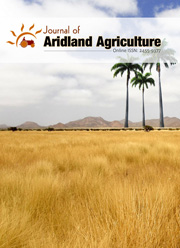Compatibility of Sorghum almum (Columbus grass) with three forage legumes
DOI:
https://doi.org/10.19071/jaa.2015.v1.202Abstract
The study evaluated compatibility of Sorghum almum (Columbus grass) forage with 3 forage legumes namely Lablab purpureus (lablab) Stylosanthes hamata (verano) and Macroptilium bracteatum (burgundy bean) in a randomized complete block design. The treatments consisted of monocultures of Sorghum almum, lablab, verano, burgundy and their mixtures in the following grass-legume proportions 4:0, 3:1. 2:2, 1:3 4:0 replicated in four blocks in accordance with de Wit’s (1960) replacement principle. The results revealed that dry matter yield values of grass monoculture were significantly greater (P<0, 05) than those of monocultures of legumes and mixtures except for monoculture of lablab found to be statistically at par with its corresponding grass monoculture. Grass-legume mixtures (2:2) tended to record higher total dry matter yield values compared to other mixtures (1:3 and 3:1) among mixtures. Relative yield total values of all mixtures were less than one except for grass-burgundy (2:2) (3.31). The legumes in mixtures were found to be more competitive than the grass given their higher relative crowding coefficient values (k). It was concluded that intercropping of grass-lablab and grass-stylo (verano) had no yield advantage compared to the corresponding grass monoculture. Also, 2:2 sowing proportion appeared to be the best given the relatively higher dry matter yield values and relative yield among mixturesDownloads
References
Aasen, A., Baron, V.S Clayton, G.W Dick, A.C and McCartney, D.H. Swath grazing potential of spring cereals, field pea and mixtures with other species. Canadian. J. Plant Sci. 2004;84:1051–1058.
Agegnehu, G. Ghizaw, A. and Sinebo, W. Yield performance and land use efficiency of
barley and faba bean mixed cropping in Ethiopian highlands, Eur. J. Agron., 2006;25: 202-227.
Anil, L., Park, J. Phipps, R.H and Miller F.A . Temperate intercropping of cerealsfor forage: a review of the potential for growth and utilization with particular reference
to the UK. Grass Forage Sci.1998;53: 301–317.
Baba, M. Halim, R.A . Alimon A.R and Abubakar, I. 2011. Grass-legume mixtures for enhanced forage production. Analysis of drymatter yield and competition indices. African J. Agric. Res. 2011; 6(23): 5242-5250.
Banik, P. Sasmal, T. Ghosal, P.K. and Bagchi, D.K. Evaluation of mustard (Brassica campestris var Toria) and legume intercropping under 1:1 and 2:1 row replacementseries systems. J . Agron. Crop .Sci. 2000:185: 9–14.
Caballero, R., Goicoechea, E.L and Hernaiz, P.J. Forage yields and quality of common vetch and oat sown at varying seeding ratios and seeding rates of vetch. Field. Crops Res. 1995;41: 135–140.
De Wit, C.T. On competition. Verslag landbouwkundig Onderzoek, 1960;66(8):1-82.
Dhima, K.V., Lithourgidis, A.S . Vasilakoglou,I.B. and Dordas, C.A . Competition
indices of common vetch and cereal intercrops in two seeding ratio. Field. Crops
Res. 2007:100: 249–256.
Ghosh, P.K. Growth, yield, competition and economics of groundnut/cereal fodder intercropping systems in the semi-arid tropics of India. Field Crops Res 2004;88: 227–237.
Ghosh, P.K, Mohanty, M., Bandyopydhyay, K.K., Painuli, D.K and .Misra, A.K. Growth
competition yield advantage and economics in Soyabean/pigeon pea inter cropping systems in semi-arid tropics of India. Effect of nutrient management. Field
Crop Res., 2006; 96: 90-97.
Javanmard, A., Nasab, A.D.M., Javanshir, A. Moghaddam, M. and Janmohammadi, H. Forage yield and quality in intercropping of maize with different legumes as double-cropped. J. Food Agric. Environ. 2009:7: 163–166.
KNARDA . Kano Agricultural and Rural Development Authority. Meteorological station record book and management. 2001; 11:1-3.
Lascano, C.E. Animal production in grass-legume pasture in tropics. In: Stomayer -Rios,
A. and W.D Pitman, editors. Tropical forage plants, Development and uses. CRC Press, Boca raton, F.L. USA, pp. 219-233;2001
Lithourgidis, A.S., Dhima, K.V., Vasilakoglou, I.B. Dordas, C.A. and Yiakoulaki, M.D. .Sustainable production of barley and wheat by intercropping common vetch. Agron. Sustainable. Development. 2007; 27:95-99.
Midya, A. Bhattacharjee, K. Ghose, S.S and Banik, P. 2005. Deferred seeding of blackgram (Phaseolus mungo L.) in rice (Oryza sativa L.) field on yield advantages and smothering of weeds. Journ. Agron . Crop Sci. 2005;191:195–201.
Osman, A.E., and Nersoyan. N. Effect of the proportion of species on the yield and quality of forage mixtures, and on the yield of barley in the following year. Experimental Agriculture.1996; 22: 345–351.
Statistical Analysis System (SAS) Institute Inc. SAS/STAT 9.2 User’s Guide, Cary USA. 2008.
Tessema, Z. and Baars, R.M.T. Chemical composition dry matter production and yield dynamics of tropical grasses mixed with perennial forage legumes. Tropical Grasslands 2006;40:150-156.




 .
.